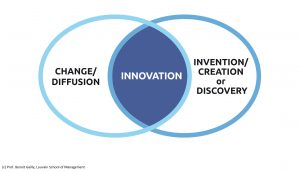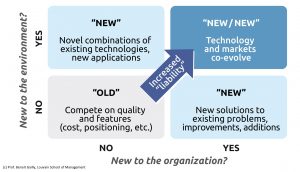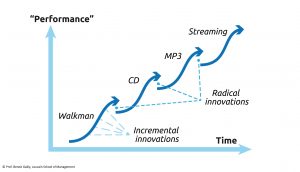NEW: Watch the executive summary
Innovation means much more than invention. Managing innovation means managing both newness and change, and the latter often matters the most.
 Newness is relative. What is today new (and valuable) to some manager, their organization or their environment might not be to others.
Newness is relative. What is today new (and valuable) to some manager, their organization or their environment might not be to others.

Innovation is about changing people’s perceptions and realities, combining many small steps and a few big bets
Bibliography
Innovation means much more than invention
Keywords: definition of innovation, innovation vs. creativity, innovation vs. invention, new combinations.
- (Book) Berkun, S. (2010), The myths of innovation, O’Reilly Media, Inc..
- (Book) De Brabandere, L. (2005). The forgotten half of change: achieving greater creativity through changes in perception, Kaplan Publishing.
- (Book) Latour, B., Woolgar, S., (1979). Laboratory Life: The Social Construction of Scientific Facts. Sage, Beverly Hills, CA.
- (Book) McKeaown M. (2008) The truth about innovation, Pearson Prentice Hall
- (Book) OECD/Eurostat (2005) Oslo Manual, 3rd edition
- (Book) Schilling M.A. (2006) “Types of Innovation” in Strategic Management of Technological Innovation (2d ed.) McGraw-Hill, Irwin,
- (Book) Schumpeter J.A. (1939), Business cycles: A theoretical, historical and statistical analysis, McGraw Hill, New York
- (Book) Tidd, Joe, Bessant, John and Pavitt, Keith (2005) Managing Innovation: Integrating Technological, Market and Organizational Change. 3rd edition. John Wiley.
- (Video) IBM Innovation Man
- (Video) Sesame Street: Paula Patton and Elmo – Innovation
- (Video) Tom Kuczmarski – How to Ignite a Culture of Innovation
- (Video) Gary Hamel, Management Innovation
(Article) Baregheh, A., Rowley, J., & Sambrook, S. (2009). Towards a multidisciplinary definition of innovation. Management Decision, 47(8), 1323-1339. - (Article) Barley, S. R. (1986). Technology as an occasion for structuring: Evidence from observations of CT scanners and the social order of radiology departments. Administrative Science Quarterly, 78-108.
- (Article) Barley, S. R. (1990). The alignment of technology and structure through roles and networks. Administrative Science Quarterly, 35(1), 61-103.
- (Article) Birkinshaw, J., Hamel, G., & Mol, M. J. (2008). Management innovation. Academy of Management Review, 33(4), 825-845.
- (Article) Brazeal, D. V., & Herbert, T. T. (1999). The genesis of entrepreneurship. Entrepreneurship Theory and Practice, 23(3), 29-46.
- (Article) Damanpour, F., & Evan, W. M. (1984). Organizational innovation and performance: the problem of “organizational lag”. Administrative Science Quarterly, 392-409.
- (Article) Dimov, D. (2007). Beyond the single-person, single-insight attribution in understanding entrepreneurial opportunities. Entrepreneurship Theory and Practice, 31(5), 713-731.
- (Article) Fagerberg, J. (2004). Innovation: a guide to the literature. Working paper
- (Article) Hage, J. T. (1999). Organizational innovation and organizational change. Annual Review of Socioogy, 25(1), 597-622.
- (Article) Kaplan, S., & Vakili, K. (2015). The double‐edged sword of recombination in breakthrough innovation. Strategic Management Journal, 36(10), 1435-1457.
- (Article) Kastelle, T., & Steen, J. (2011). Ideas are not innovations. Prometheus, 29(2), 199-205.
- (Article) Levitt, T. (2002). Creativity is not enough. Harvard Business Review, 80, 137-144.
- (Article) Linton, J. D. (2009). De-babelizing the language of innovation. Technovation, 29(11), 729-737.
- (Article) Nelson, R. R., & Winter, S. G. (1977). In search of useful theory of innovation. Research Policy, 6(1), 36-76.
- (Article) Rothwell, R., Freeman, C., Horlsey, A., Jervis, V. T. P., Robertson, A. B., & Townsend, J. (1974). SAPPHO updated-project SAPPHO phase II. Research Policy, 3(3), 258-291.
- (Article) Singh, J., & Fleming, L. (2010). Lone inventors as sources of breakthroughs: Myth or reality?. Management Science, 56(1), 41-56.
- (Article) Wolfe R.A. (1994), « Organizational innovation: review, critique and suggested research directions », Journal of Management Studies, 31(3) p. 405
- (Article) Zhang, J. A., Garrett-Jones, S., & Szeto, R. (2013). Innovation capability and market performance: the moderating effect of industry dynamism. International Journal of Innovation Management, 17(02), 1350004.
Newness is relative
Keywords: crossing the chasm, early adopters, liability of newness, newness is relative, novelty.
- (Book) Evans, H., Buckland, G., & Lefer, D. (2009). They made America: From the steam engine to the search engine: Two centuries of innovators. Hachette UK.
- (Book) Johnson, S. (2010). Where good ideas come from: The natural history of innovation. Penguin UK.
- (Book) Moore, G. A. (1991) Crossing the Chasm: Marketing and selling high-tech goods to mainstream customers.
- (Video) J Bezos the electricity revolution
- (Video) The Transformation of the Desk by TechSoEasy
- (Video) Bath, W. Crossing the Chasm – Disruptive Innovation – Technology Adoption Life Cycle.
- (Article) Berry, H. (2015). Knowledge inheritage in global industries: ‘The impact of parent firm knowledge on the performance of foreign subsidiaries’. Academy of Management Journal, 58, 1438-1458.
- (Article) Danneels, E., & Kleinschmidtb, E. J. (2001). Product innovativeness from the firm’s perspective: Its dimensions and their relation with project selection and performance. Journal of Product Innovation Management, 18(6), 357-373.
- (Article) Feiereisen, S., Wong, V., & Broderick, A. J. (2013). Is a Picture Always Worth a Thousand Words? The Impact of Presentation Formats in Consumers’ Early Evaluations of Really New Products (RNP s). Journal of Product Innovation Management, 30, 159-173.
- (Article) Freeman, J., Carroll, G. R., & Hannan, M. T. (1983). The liability of newness: Age dependence in organizational death rates. American Sociological Review, 692-710.
- (Article) Garcia, R., & Calantone, R. (2002). A critical look at technological innovation typology and innovativeness terminology: a literature review. Journal of Product Innovation Management, 19(2), 110-132.
- (Article) Hoeffler, S. (2003). Measuring preferences for really new products. Journal of Marketing Research, 40(4), 406-420.
- (Article) Kock, A., Gemünden, H. G., Salomo, S., & Schultz, C. (2011). The mixed blessings of technological innovativeness for the commercial success of new products. Journal of Product Innovation Management, 28(s1), 28-43.
- (Article) Mueller, J. S., Melwani, S., & Goncalo, J. A. (2012). The bias against creativity: Why people desire but reject creative ideas. Psychological Science, 23(1), 13-17.
- (Article) Snyder, H., Witell, L., Gustafsson, A., Fombelle, P., & Kristensson, P. (2016). Identifying categories of service innovation: A review and synthesis of the literature. Journal of Business Research, 69(7), 2401-2408.
- (Article) Talke, K., Salomo, S., Wieringa, J. E., & Lutz, A. (2009). What about design newness? Investigating the relevance of a neglected dimension of product innovativeness. Journal of Product Innovation Management, 26(6), 601-615.
- (Article) Thornhill, S., & Amit, R. (2003). Learning about failure: Bankruptcy, firm age, and the resource-based view. Organization Science, 14(5), 497-509.
- (Article) Uzzi, B., Mukherjee, S., Stringer, M., & Jones, B. (2013). Atypical combinations and scientific impact. Science, 342(6157), 468-472.
- (Article) Van de Ven, A.H. (1986). Central problems in the management of innovation. Management Science, 32(5), 590-607.
- (Article) Wang, J., Veugelers, R., & Stephan, P. (2017). Bias against novelty in science: A cautionary tale for users of bibliometric indicators. Research Policy, 46(8), 1416-1436.
- (Article) Yayavaram, S., & Chen, W. (2015). ‘Changes in firm knowledge couplings and firm innovation performance: the moderating role of technological complexity’. Strategic Management Journal, 36, 377-396.
Many small steps and a few big bets
Keywords: architectural innovation, continuous improvement, dominant design, incremental vs. radical innovations, operational effectiveness, paradigms.
- (Book) Govindarajan, V. and Trimble, C. (2010) The other side of innovation: solving the execution challenge” Harvard Business Review Press
- (Book) Hege, J. B. (2001). The Wankel rotary engine: a history. McFarland.
- (Book) Tushman, M.L. and O’Reilly, C.A. (2002) Winning through Innovation, Harvard Business School Press,
- (Video) Dick Fosbury flop – Mexico 1968 high jump final
- (Video) Vijay Govindarajan: why most companies fail at innovation
- (Video) What is innovation? de Rafa Galeano (on Vimeo)
- (Video) Making a Lego car cross gaps (incremental innovations) The Brick Experiment Channel https://www.youtube.com/watch?v=pwglOlD7e0M
- (Article) Adner, R., & Snow, D. (2010). Old technology responses to new technology threats: demand heterogeneity and technology retreats. Industrial and Corporate Change, 19(5), 1655-1675
- (Article) Adner, R., & Kapoor, R. (2016). Innovation ecosystems and the pace of substitution: Re‐examining technology S‐curves. Strategic Management Journal, 37(4), 625-648.
- (Article) Aghion, P., Harris, C., Howitt, P., & Vickers, J. (2001). Competition, imitation and growth with step-by-step innovation. The Review of Economic Studies, 68(3), 467-492.
- (Article) Ansari, S., & Garud, R. (2009). Inter-generational transitions in socio-technical systems: The case of mobile communications. Research Policy, 38(2), 382-392.
- (Article) Atuahene-Gima, K. (2005). Resolving the capability–rigidity paradox in new product innovation. Journal of Marketing, 69(4), 61-83.
- (Article) Bakker, S., van Lente, H., & Meeus, M. T. (2012). Dominance in the prototyping phase—The case of hydrogen passenger cars. Research Policy, 41(5), 871-883.
- (Article) Bhaskaran, S. (2006). Incremental innovation and business performance: small and medium‐size food enterprises in a concentrated industry environment. Journal of Small Business Management, 44(1), 64-80.
- (Article) Benner, M. J. (2010). Securities analysts and incumbent response to radical technological change: Evidence from digital photography and internet telephony. Organization Science, 21(1), 42-62
- (Article) Bessant, J., Caffyn, S., Gilbert, J., Harding, R., & Webb, S. (1994). Rediscovering continuous improvement. Technovation, 14(1), 17-29.
- (Article) Bessant, J., Lamming, R., Noke, H., & Phillips, W. (2005). Managing innovation beyond the steady state. Technovation, 25(12), 1366-1376.
- (Article) Cappetta, R., Cillo, P., & Ponti, A. (2006). Convergent designs in fine fashion: An evolutionary model for stylistic innovation. Research Policy, 35(9), 1273-1290.
- (Article) Chandy, R. K., & Tellis, G. J. (2000). The incumbent’s curse? Incumbency, size, and radical product innovation. Journal of Marketing, 64(3), 1-17.
- (Article) Chang, Y. C., Chang, H. T., Chi, H. R., Chen, M. H., & Deng, L. L. (2012). How do established firms improve radical innovation performance? The organizational capabilities view. Technovation, 32(7), 441-451.
- (Article) Dahlin, K. B., & Behrens, D. M. (2005). When is an invention really radical?: Defining and measuring technological radicalness. Research Policy, 34(5), 717-737.
- (Article) Damanpour F. & Evan, W. (1996). ‘Organizational innovation and performance. The problem of organizational lag’, Administrative Sciences Quarterly, 29, 392-409.
- (Article) David, P.A. (1985). Clio and the Economics of QWERTY. The American Economic Review, 75(2), 332-337.
- (Article) Dewald, J., & Bowen, F. (2010). Storm clouds and silver linings: Responding to disruptive innovations through cognitive resilience. Entrepreneurship Theory and Practice, 34(1), 197-218.
- (Article) Dewar, R.D. & Dutton, J.E. (1986). The Adoption of Radical and Incremental Innovations: An Empirical Analysis. Management Science, 32(11), 1422-1433
- (Article) Dosi, G. (1982). Technological paradigms and technological trajectories: a suggested interpretation of the determinants and directions of technical change. Research Policy, 11(3), 147-162.
- (Article) Ettlie, J. E., Bridges, W. P., & O’keefe, R. D. (1984). Organization strategy and structural differences for radical versus incremental innovation. Management Science, 30(6), 682-695.
- (Article) Fleming, L. (2001). Recombinant uncertainty in technological search. Management Science, 47(1), 117-132.
- (Article) Francis, D., Bessant, J., & Hobday, M. (2003). Managing radical organisational transformation. Management Decision. 41(1), 18-31
- (Article) Funk, R. J., & Owen-Smith, J. (2017). A dynamic network measure of technological change. Management Science, 63(3), 791-817
- (Article) Furr, N.R., & Snow, D.C. (2014). Intergenerational Hybrids: Spillbacks, Spillforwards, and Adapting to Technology Discontinuities. Organization Science, 26(2), 475-493.
- (Article) Gatignon, H., Tushman, M. L., Smith, W., & Anderson, P. (2002). A structural approach to assessing innovation: Construct development of innovation locus, type, and characteristics. Management Science, 48(9), 1103-1122.
- (Article) Godoe, H. (2000). Innovation regimes, R&D and radical innovations in telecommunications. Research Policy, 29(9), 1033-1046
- (Article) Govindarajan, V., & Kopalle, P.K. (2006). Disruptiveness of innovations: measurement and an assessment of reliability and validity. Strategic Management Journal, 27(2), 189-199.
- (Article) Greenwood, R., & Hinings, C. R. (1996). Understanding radical organizational change: Bringing together the old and the new institutionalism. Academy of Management Review, 21(4), 1022-1054.
- (Article) Grossman, G. M., & Helpman, E. (1991). Quality ladders in the theory of growth. The Review of Economic Studies, 58(1), 43-61.
- (Article) Henderson, R.M. & Clark, K.B. (1990). Architectural innovation: the reconfiguration of existing product technologies and the failures of established firms. Administrative Science Quarterly, 35, 9-30.
- (Article) Howells, J. (2002). The response of old technology incumbents to technological competition–does the sailing ship effect exist?. Journal of Management Studies, 39(7), 887-906.
- (Article) Jones, N. (2003). Competing after radical technological change: The significance of product line management strategy. Strategic Management Journal, 24(13), 1265-1287.
- (Article) Kaplan, S. (2008). Cognition, capabilities, and incentives: Assessing firm response to the fiber-optic revolution. Academy of Management Journal, 51(4), 672-695.
- (Article) Kelly, B., Papanikolaou, D., Seru, A., & Taddy, M. (2021). Measuring technological innovation over the long run. American Economic Review: Insights, 3(3), 303-20.
- (Article) Klepper, S. (1996). Entry, exit, growth, and innovation over the product life cycle. The American Economic Review, 562-583.
- (Article) Knight, K. E. (1967). A descriptive model of the intra-firm innovation process. The Journal of Business, 40(4), 478-496.
- (Article) Koberg, C. S., Detienne, D. R., & Heppard, K. A. (2003). An empirical test of environmental, organizational, and process factors affecting incremental and radical innovation. The Journal of High Technology Management Research, 14(1), 21-45.
- (Article) Lee, S. M., & Trimi, S. (2021). Convergence innovation in the digital age and in the COVID-19 pandemic crisis. Journal of Business Research, 123, 14-22.
- (Article) Li, Y., Vanhaverbeke, W., & Schoenmakers, W. (2008). Exploration and exploitation in innovation: Reframing the interpretation. Creativity and Innovation Management, 17(2), 107-126.
- (Article) Macher, J. T., & Richman, B. D. (2004). Organisational responses to discontinuous innovation: a case study approach. International Journal of Innovation Management, 8(01), 87-114.
- (Article) McDermott, C. M., & O’Connor, G. C. (2002). Managing radical innovation: an overview of emergent strategy issues. Journal of Product Innovation Management, 19(6), 424-438.
- (Article) McLaughlin, P., Bessant, J., & Smart, P. (2008). Developing an organisation culture to facilitate radical innovation. International Journal of Technology Management, 44(3-4), 298-323.
- (Article) Mezias, S.J., & Glynn, M.A. (1993). The three faces of corporate renewal: Institution, revolution, and evolution. Strategic Management Journal, 14(2), 77-101.
- (Article) Miu, E., Gulley, N., Laland, K. N., & Rendell, L. (2018). Innovation and cumulative culture through tweaks and leaps in online programming contests. Nature Communications, 9(1), 2321.
- (Article) Phillips, W., Noke, H., Bessant, J., & Lamming, R. (2006). Beyond the steady state: managing discontinuous product and process innovation. International Journal of Innovation Management, 10(02), 175-196.
- (Article) Sandberg, B., & Aarikka-Stenroos, L. (2014). What makes it so difficult? A systematic review on barriers to radical innovation. Industrial Marketing Management, 43(8), 1293-1305.
- (Article) Sainio, L. M., Ritala, P., & Hurmelinna-Laukkanen, P. (2012). Constituents of radical innovation—exploring the role of strategic orientations and market uncertainty. Technovation, 32(11), 591-599.
- (Article) Schiavone, F. (2011). Strategic reactions to technology competition: A decision-making model. Management Decision, 49(5), 801-809.
- (Article) Schilling, M. A. (1998). Technological lockout: An integrative model of the economic and strategic factors driving technology success and failure. Academy of Management Review, 23(2), 267-284.
- (Article) Slater, S. F., Mohr, J. J., & Sengupta, S. (2014). Radical product innovation capability: Literature review, synthesis, and illustrative research propositions. Journal of Product Innovation Management, 31(3), 552-566.
- (Article) Soh, P.H. (2010). Network patterns and competitive advantage before the emergence of a dominant design. Strategic Management Journal, 31(4), 438-461.
- (Article) Tongur, S., & Engwall, M. (2014). The business model dilemma of technology shifts. Technovation, 34(9), 525-535.
- (Article) Tushman, M.L. and Anderson, P. (1988). “Technological discontinuities and organizational environments” Administrative Science Quarterly, 31, 439-465.
- (Article) Utterback, J.M. & Aberbathy W. (1975). “A dynamic model of process and product innovation” Omega, 33, 639-656.
(c) Prof. Benoit Gailly, Louvain School of Management


